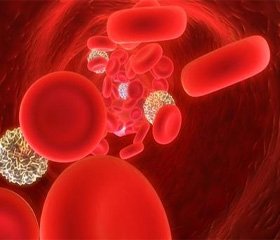Журнал «Здоровье ребенка» 4 (55) 2014
Вернуться к номеру
Development of thrombosis in child hood acute lymphoblastic leukemia
Авторы: L.Ya. Dubey - Lviv National Medical University named Danylo Galytzky, Lviv; O.I. Dorosh - Western Specialized Children''s Medical Center, Lviv; N.V. Dubey - State Institution «Institute of Blood Pathology and Transfusion Medicine of NAMS of Ukraine», Lviv; I.P. Tsymbaliuk - Lviv National Medical University named Danylo Galytzky, Lviv, Western Specialized Children''s Medical Center, Lviv; O.I. Kozlova - Western Specialized Children''s Medical Center, Lviv; G.V. Makuch - State Institution «Institute of Hereditary Pathology of NAMS of Ukraine» Lviv; M.V. Sapuzhak - Western Specialized Children''s Medical Center, Lviv
Рубрики: Педиатрия/Неонатология
Разделы: Справочник специалиста
Версия для печати
One of the most common forms of neoplasia in childhood is acute lymphoblastic leukemia (ALL), which is highly sensitive to chemotherapy. Among patients receiving modern therapy, the overall five-year survival ranges from 80 to 86 %, and five-year event free survival – from 78 to 83 %, even reaching 90 % in some subgroup. Although most of these patients are likely to be cured, but many of them relapse, develope a secondary tumor, or some other complications associated with treatment, leading to death. Adverse events during and after treatment in children ALL is one of the burning topics of today.
The frequency of increased risk of thrombosis in children ranged from 1,1 to 36,7 %. This rather large difference is related to several factors, such as different treatment of thrombosis (symptomatic or asymptomatic), various methods of diagnosis, and differences in treatment protocols of ALL in children. Until recently, the incidence of thrombosis during treatment (from diagnosis to end of therapy) was 5,2 %.
A different researches show that venous thromboembolism (VTE) associated with ALL in children is polyethiologic: interaction of disease, used chemotherapy, and its consequences, and possibly congenital (inherited) prothrombotic status of the patient. A spread prothrombotic defect depends on belonging to an ethnic group.
Changes in the blood coagulation system are often observed in children with ALL. Cases of
thrombosis are well described in patients receiving L-asparaginase (LASP) as monotherapy or in combination with other chemotherapeutic drugs. There are studies that evaluated different types of LASP and steroids. It should be noted that not only the type of LASP, but its dosage are important in causing of thrombosis in the treatment of ALL in children. Thus, there is a high incidence of thrombosis at low doses of LASP and prolonged its application (under 6000 U/m2 and 9 days) in combination with anthracyclines and prednisone (instead dexamethasone).
The main risk factor, accounting for over two-thirds of VTE in children is the presence of a central catheter needed for providing of ALL program. Pathogenetic mechanisms of catheter-related VTE defined by intravascular presence of a foreign surface, obstruction of venous blood flow, and
venous wall injury during the installation of a central catheter and stimulation of endothelium by catheter or infusion solutions.
Thromboembolic complications often arise when central catheter installing left-sided in the subclavian vein via open (surgical) way. There is a smaller risk of thrombosis in transcutaneous application (puncture method) of catheter in the jugular vein. Today, it remains unclear optimal time presence of central venous catheters in children with ALL, and its type (internal or external). Internal ports need to be prioritized on the type of central venous catheter due to lower risk of infectious and thrombotic complications. In addition, there is a higher risk of getting the positive microbiological tests of blood culture when use of central venous catheter to 15 days at the stage of induction chemotherapy course than after 15 days on the same stage.
In children with ALL VTE often has intracranial localization. Sinusthrombosis of dural mater in children with solid tumors during treatment by LASP is associated with deficiency of AT III. It is also observed in patients with leukemia, although occurring in patients with ALL who did not receive LASP.
It is important the increasing of FVIII activity, recently highlighted its as one of the independent prothrombotic risk factors that deserve attention in children treated on ALL. Distribution of FVIII activity increasing is about 20 %. How elevated levels of FVIII leads to venous thrombosis is still unclear.
The risk of thrombosis increases when it is accompanied by additional prothrombotic risk factors. So first of all children with malignant tumors and high risk of thrombosis, as well as those who receive LASP or laying down a central venous catheter during treatment should be examined for additional prothrombotic risk factors.
There is no clear solution for the treatment of thrombosis. According to the latest data the low molecular weight heparin provides effective and safe alternative to unfractionated heparin in the treatment of thrombosis in both newborns and older children and adolescents. In childhood, for the treatment of VTE preferred low molecular weight heparin. If anticoagulant therapy was successful, then a prophylactic measure should reduce the dose of LMWH. Monitoring anticoagulant therapy should be carried out by analysis of anti-Xa activity. Rethrombosis or adverse events, including heparin-induced thrombocytopenia are very common in childhood.

